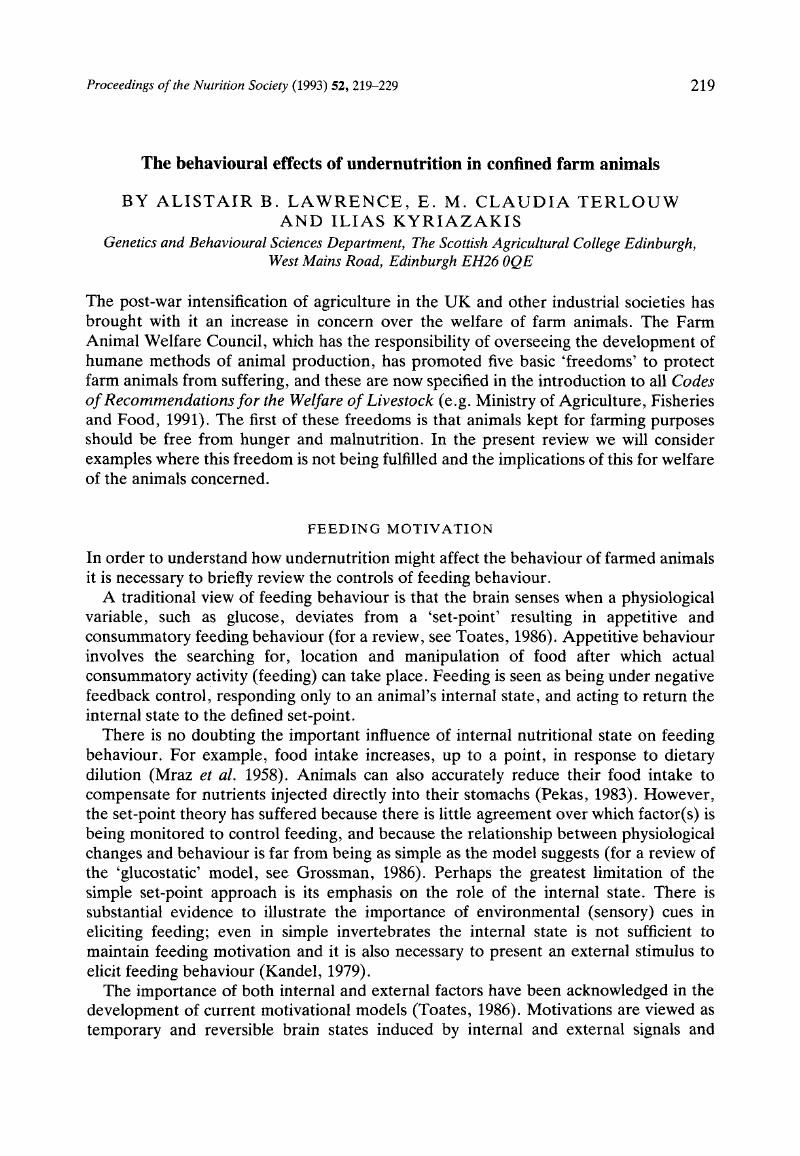Crossref Citations
This article has been cited by the following publications. This list is generated based on data provided by Crossref.
Day, J.E.L.
Busch, M.E.
Kyriazakis, I.
and
Lawrence, A.B.
1995.
An investigation into the potential use of a second order schedule of operant reinforcement for measuring feeding motivation in the pig.
Proceedings of the British Society of Animal Science,
Vol. 1995,
Issue. ,
p.
68.
Day, J.E.L.
Busch, M.E.
Kyriazakis, I.
and
Lawrence, A.B.
1995.
An investigation into the potential use of a second order schedule of operant reinforcement for measuring feeding motivation in the pig.
Proceedings of the British Society of Animal Science,
Vol. 1995,
Issue. ,
p.
68.
Day, J. E. L.
Kyriazakis, I.
and
Lawrence, A. B.
1996.
The use of a second-order schedule to assess the effect of food bulk on the feeding motivation of growing pigs.
Animal Science,
Vol. 63,
Issue. 3,
p.
447.
Kyriazakis, I.
1997.
The nutritional choices of farm animals: to eat or what to eat?.
BSAP Occasional Publication,
Vol. 20,
Issue. ,
p.
55.
Young, Robert J.
1997.
The importance of food presentation for animal welfare and conservation.
Proceedings of the Nutrition Society,
Vol. 56,
Issue. 3,
p.
1095.
Würbel, H
Freire, R
and
Nicol, C.J
1998.
Prevention of stereotypic wire-gnawing in laboratory mice: Effects on behaviour and implications for stereotypy as a coping response.
Behavioural Processes,
Vol. 42,
Issue. 1,
p.
61.
Tsaras, L. N.
Kyriazakis, I.
and
Emmans, G. C.
1998.
The prediction of the voluntary food intake of pigs on poor quality foods.
Animal Science,
Vol. 66,
Issue. 3,
p.
713.
Day, Jon E. L.
Kyriazakis, Ilias
and
Rogers, Peter J.
1998.
Food choice and intake: towards a unifying framework of learning and feeding motivation.
Nutrition Research Reviews,
Vol. 11,
Issue. 1,
p.
25.
Würbel, Hanno
Chapman, Rosemary
and
Rutland, Craig
1998.
Effect of feed and environmental enrichment on development of stereotypic wire-gnawing in laboratory mice.
Applied Animal Behaviour Science,
Vol. 60,
Issue. 1,
p.
69.
Rushen, J.
Robert, S.
and
Farmer, C.
1999.
Effects of an oat-based high-fibre diet on insulin, glucose, cortisol and free fatty acid concentrations in gilts.
Animal Science,
Vol. 69,
Issue. 2,
p.
395.
Day, J.E.L
Burfoot, A
Docking, C.M
Whittaker, X
Spoolder, H.A.M
and
Edwards, S.A
2002.
The effects of prior experience of straw and the level of straw provision on the behaviour of growing pigs.
Applied Animal Behaviour Science,
Vol. 76,
Issue. 3,
p.
189.
Rushen, Jeffrey
2003.
Changing concepts of farm animal welfare: bridging the gap between applied and basic research.
Applied Animal Behaviour Science,
Vol. 81,
Issue. 3,
p.
199.
Toscano, M. J.
Lay, D. C.
Craig, B. A.
and
Pajor, E. A.
2007.
Assessing the adaptation of swine to fifty-seven hours of feed deprivation in terms of behavioral and physiological responses1.
Journal of Animal Science,
Vol. 85,
Issue. 2,
p.
441.
Hill, S.R.
Knowlton, K.F.
James, R.E.
Pearson, R.E.
Bethard, G.L.
and
Pence, K.J.
2007.
Nitrogen and Phosphorus Retention and Excretion in Late-Gestation Dairy Heifers.
Journal of Dairy Science,
Vol. 90,
Issue. 12,
p.
5634.
Bruni, Andrea
Quinton, V. Margaret
and
Widowski, Tina M.
2008.
The effect of feed restriction on belly nosing behaviour in weaned piglets.
Applied Animal Behaviour Science,
Vol. 110,
Issue. 1-2,
p.
203.
Day, Jon E.L.
Van de Weerd, Heleen A.
and
Edwards, Sandra A.
2008.
The effect of varying lengths of straw bedding on the behaviour of growing pigs.
Applied Animal Behaviour Science,
Vol. 109,
Issue. 2-4,
p.
249.
D'Eath, Richard B.
Tolkamp, Bert J.
Kyriazakis, Ilias
and
Lawrence, Alistair B.
2009.
‘Freedom from hunger’ and preventing obesity: the animal welfare implications of reducing food quantity or quality.
Animal Behaviour,
Vol. 77,
Issue. 2,
p.
275.
Benhaïm, David
and
Koch-Schott, Claudine
2009.
Éthologie appliquée.
p.
223.
Verbeek, E.
Waas, J.R.
Oliver, M.H.
McLeay, L.M.
Ferguson, D.M.
and
Matthews, L.R.
2012.
Motivation to obtain a food reward of pregnant ewes in negative energy balance: Behavioural, metabolic and endocrine considerations.
Hormones and Behavior,
Vol. 62,
Issue. 2,
p.
162.
Pastorelli, H.
Le Floc'h, N.
Merlot, E.
Meunier-Salaün, M. C.
van Milgen, J.
and
Montagne, L.
2012.
Feed restriction applied after weaning has different effects on pig performance and health depending on the sanitary conditions1.
Journal of Animal Science,
Vol. 90,
Issue. 13,
p.
4866.



